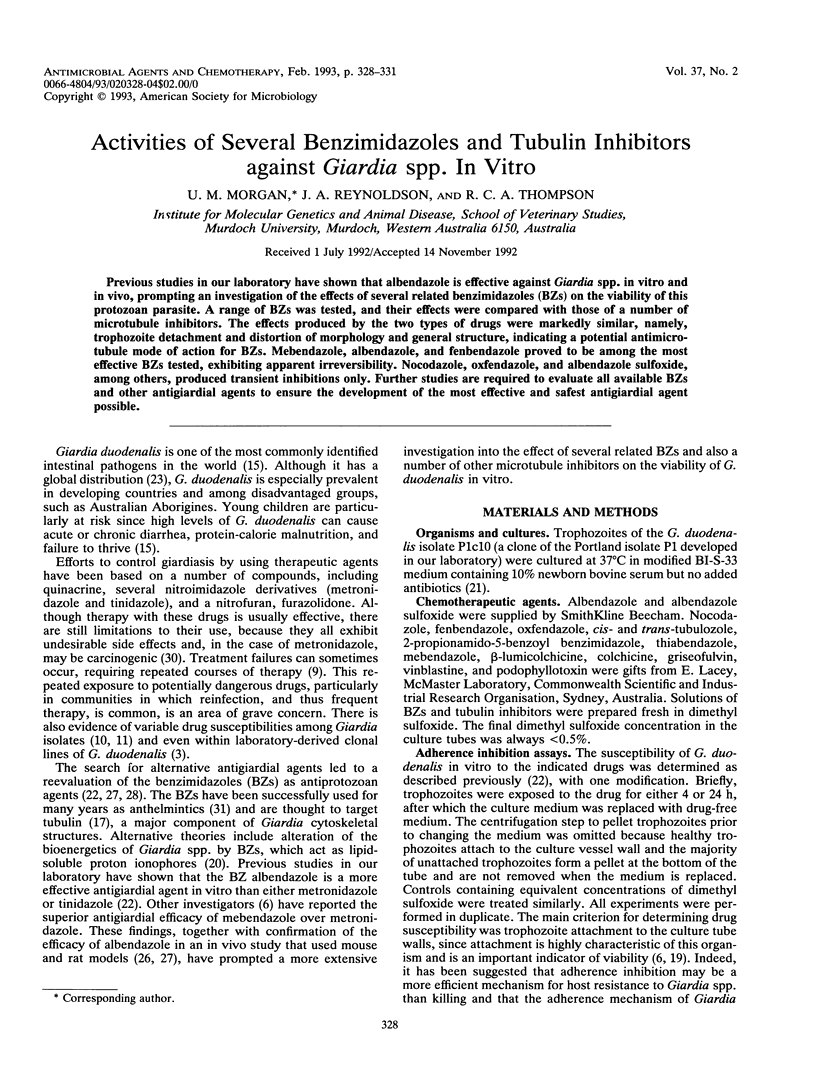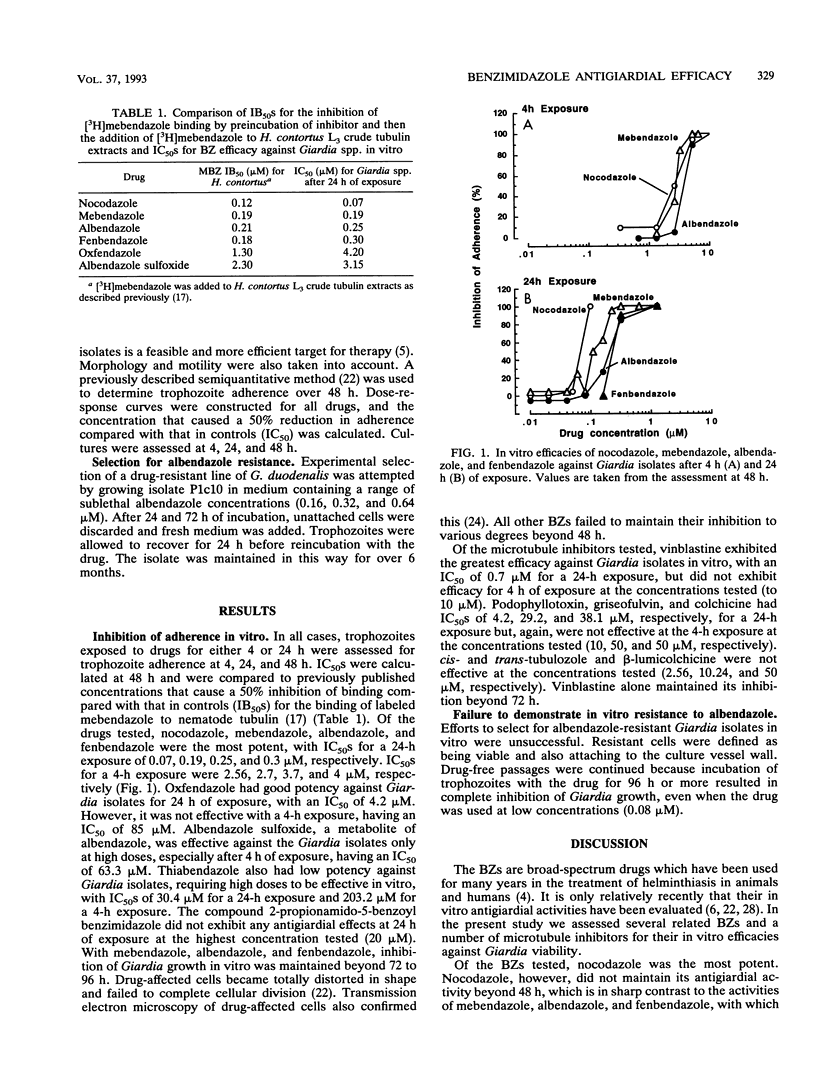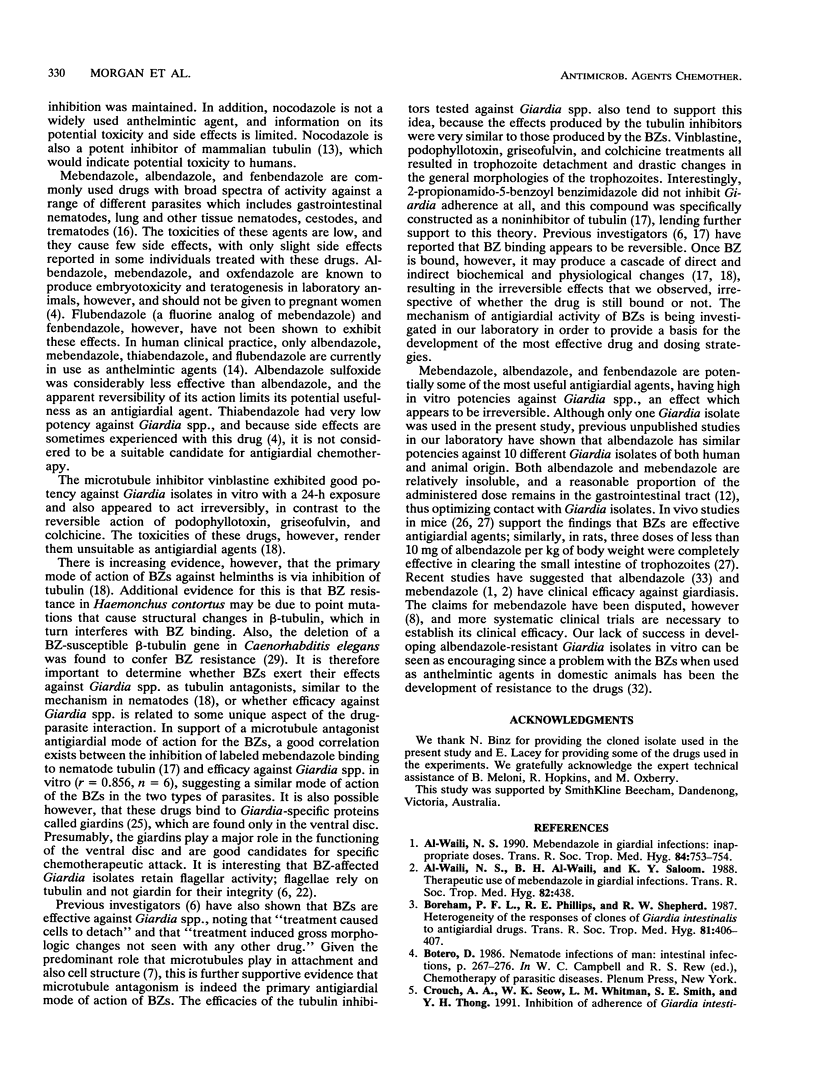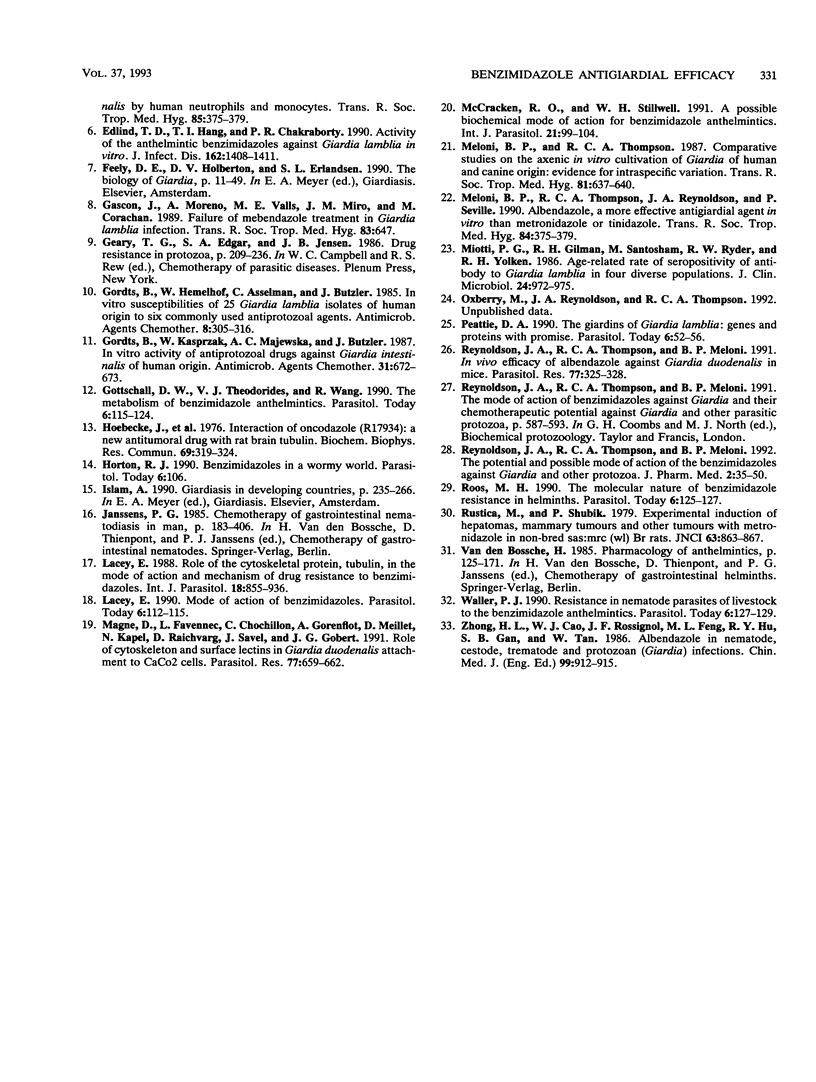Abstract
Previous studies in our laboratory have shown that albendazole is effective against Giardia spp. in vitro and in vivo, prompting an investigation of the effects of several related benzimidazoles (BZs) on the viability of this protozoan parasite. A range of BZs was tested, and their effects were compared with those of a number of microtubule inhibitors. The effects produced by the two types of drugs were markedly similar, namely, trophozoite detachment and distortion of morphology and general structure, indicating a potential antimicrotubule mode of action for BZs. Mebendazole, albendazole, and fenbendazole proved to be among the most effective BZs tested, exhibiting apparent irreversibility. Nocodazole, oxfendazole, and albendazole sulfoxide, among others, produced transient inhibitions only. Further studies are required to evaluate all available BZs and other antigiardial agents to ensure the development of the most effective and safest antigiardial agent possible.
Full text
PDF



Selected References
These references are in PubMed. This may not be the complete list of references from this article.
- Boreham P. F., Phillips R. E., Shepherd R. W. Heterogeneity in the responses of clones of Giardia intestinalis to anti-giardial drugs. Trans R Soc Trop Med Hyg. 1987;81(3):406–407. doi: 10.1016/0035-9203(87)90151-9. [DOI] [PubMed] [Google Scholar]
- Crouch A. A., Seow W. K., Whitman L. M., Smith S. E., Thong Y. H. Inhibition of adherence of Giardia intestinalis by human neutrophils and monocytes. Trans R Soc Trop Med Hyg. 1991 May-Jun;85(3):375–379. doi: 10.1016/0035-9203(91)90297-c. [DOI] [PubMed] [Google Scholar]
- Edlind T. D., Hang T. L., Chakraborty P. R. Activity of the anthelmintic benzimidazoles against Giardia lamblia in vitro. J Infect Dis. 1990 Dec;162(6):1408–1411. doi: 10.1093/infdis/162.6.1408. [DOI] [PubMed] [Google Scholar]
- Gascon J., Moreno A., Valls M. E., Miró J. M., Corachán M. Failure of mebendazole treatment in Giardia lamblia infection. Trans R Soc Trop Med Hyg. 1989 Sep-Oct;83(5):647–647. doi: 10.1016/0035-9203(89)90384-2. [DOI] [PubMed] [Google Scholar]
- Gordts B., De Jonckheere J., Kasprzak W., Majewska A. C., Butzler J. P. In vitro activity of antiprotozoal drugs against Giardia intestinalis of human origin. Antimicrob Agents Chemother. 1987 Apr;31(4):672–673. doi: 10.1128/aac.31.4.672. [DOI] [PMC free article] [PubMed] [Google Scholar]
- Gottschall D. W., Theodorides V. J., Wang R. The metabolism of benzimidazole anthelmintics. Parasitol Today. 1990 Apr;6(4):115–124. doi: 10.1016/0169-4758(90)90228-v. [DOI] [PubMed] [Google Scholar]
- Hoebeke J., Van Nijen G., De Brabander M. Interaction of oncodazole (R 17934), a new antitumoral drug, with rat brain tubulin. Biochem Biophys Res Commun. 1976 Mar 22;69(2):319–324. doi: 10.1016/0006-291x(76)90524-6. [DOI] [PubMed] [Google Scholar]
- Horton R. J. Benzimidazoles in a wormy world. Parasitol Today. 1990 Apr;6(4):106–106. doi: 10.1016/0169-4758(90)90225-s. [DOI] [PubMed] [Google Scholar]
- Lacey E. Mode of action of benzimidazoles. Parasitol Today. 1990 Apr;6(4):112–115. doi: 10.1016/0169-4758(90)90227-u. [DOI] [PubMed] [Google Scholar]
- Lacey E. The role of the cytoskeletal protein, tubulin, in the mode of action and mechanism of drug resistance to benzimidazoles. Int J Parasitol. 1988 Nov;18(7):885–936. doi: 10.1016/0020-7519(88)90175-0. [DOI] [PubMed] [Google Scholar]
- Magne D., Favennec L., Chochillon C., Gorenflot A., Meillet D., Kapel N., Raichvarg D., Savel J., Gobert J. G. Role of cytoskeleton and surface lectins in Giardia duodenalis attachment to Caco2 cells. Parasitol Res. 1991;77(8):659–662. doi: 10.1007/BF00928679. [DOI] [PubMed] [Google Scholar]
- McCracken R. O., Stillwell W. H. A possible biochemical mode of action for benzimidazole anthelmintics. Int J Parasitol. 1991 Feb;21(1):99–104. doi: 10.1016/0020-7519(91)90125-q. [DOI] [PubMed] [Google Scholar]
- Meloni B. P., Thompson R. C. Comparative studies on the axenic in vitro cultivation of Giardia of human and canine origin: evidence for intraspecific variation. Trans R Soc Trop Med Hyg. 1987;81(4):637–640. doi: 10.1016/0035-9203(87)90438-x. [DOI] [PubMed] [Google Scholar]
- Meloni B. P., Thompson R. C., Reynoldson J. A., Seville P. Albendazole: a more effective antigiardial agent in vitro than metronidazole or tinidazole. Trans R Soc Trop Med Hyg. 1990 May-Jun;84(3):375–379. doi: 10.1016/0035-9203(90)90324-8. [DOI] [PubMed] [Google Scholar]
- Miotti P. G., Gilman R. H., Santosham M., Ryder R. W., Yolken R. H. Age-related rate of seropositivity of antibody to Giardia lamblia in four diverse populations. J Clin Microbiol. 1986 Dec;24(6):972–975. doi: 10.1128/jcm.24.6.972-975.1986. [DOI] [PMC free article] [PubMed] [Google Scholar]
- Peattie D. A. The giardins of Giardia lamblia: genes and proteins with promise. Parasitol Today. 1990 Feb;6(2):52–56. doi: 10.1016/0169-4758(90)90070-k. [DOI] [PubMed] [Google Scholar]
- Reynoldson J. A., Thompson R. C., Meloni B. P. In vivo efficacy of albendazole against Giardia duodenalis in mice. Parasitol Res. 1991;77(4):325–328. doi: 10.1007/BF00930909. [DOI] [PubMed] [Google Scholar]
- Roos M. H. The molecular nature of benzimidazole resistance in helminths. Parasitol Today. 1990 Apr;6(4):125–127. doi: 10.1016/0169-4758(90)90229-w. [DOI] [PubMed] [Google Scholar]
- Rustia M., Shubik P. Experimental induction of hepatomas, mammary tumors, and other tumors with metronidazole in noninbred Sas:MRC(WI)BR rats. J Natl Cancer Inst. 1979 Sep;63(3):863–868. doi: 10.1093/jnci/63.3.863. [DOI] [PubMed] [Google Scholar]
- Waller P. J. Resistance in nematode parasites of livestock to the benzimidazole anthelmintics. Parasitol Today. 1990 Apr;6(4):127–129. doi: 10.1016/0169-4758(90)90230-2. [DOI] [PubMed] [Google Scholar]
- Zhong H. L., Cao W. J., Rossignol J. F., Feng M. L., Hu R. Y., Gan S. B., Tan W. Albendazole in nematode, cestode, trematode and protozoan (Giardia) infections. Chin Med J (Engl) 1986 Nov;99(11):912–915. [PubMed] [Google Scholar]
- al-Waili N. S. Mebendazole in giardial infections: inappropriate doses. Trans R Soc Trop Med Hyg. 1990 Sep-Oct;84(5):753–754. doi: 10.1016/0035-9203(90)90179-i. [DOI] [PubMed] [Google Scholar]
- al-Waili N. S., al-Waili B. H., Saloom K. Y. Therapeutic use of mebendazole in giardial infections. Trans R Soc Trop Med Hyg. 1988;82(3):438–438. doi: 10.1016/0035-9203(88)90156-3. [DOI] [PubMed] [Google Scholar]


